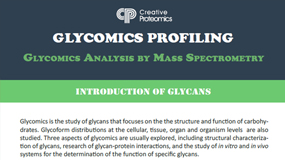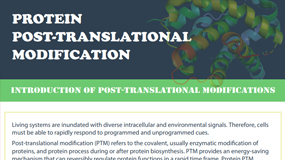Glycomics is to characterize the glycosylation and quantification of protein glycosylation is required to distinguish this subtle difference including glycan biomarkers identification for diagnosis, prognosis, and drug metabolism and pharmacokinetics. The absolute quantification is defined to determine the exact sample concentrations for individual glycans while a relative quantification provides only a percentage of the normalized total glycan content. Absolute quantification is often difficult, because samples are normally analyzed individually by comparison of data from mass spectrometry (MS), or chromatography, where subtle qualitative and/or quantitative difference is often missed. As the content of individual glycans is significantly important for glycan function, absolute glycan quantification is biologically relevant and capable of providing a overview of disease related changes of glycosylation. MS in combination with stable isotope labeling for quantitative analysis has been defined as a routine methodoloy in metabolomics and proteomics. It has been employed for the quantitative analysis in glycomics.
Stable isotope mediated glycan quantification can be performed by spiking isotope enriched standards into the sample or by labeling the entire glycan mixture with a heavy-isotope labeled tag.
1. Stable isotope labeled tags
Due to a lack of heavy-isotope labeled glycan standards, heavy-isotope based strategies for glycan quantification were mainly focused on the incorporation of stable isotope labeled tags into the glycan samples for differential quantitative glycan analysis. An effective method is to permethylate glycans using different isotopically labeled methyl iodide reagents. This method expanded using singly, doubly, and triply deuteriated methyl iodide agent, thus allowed tetraplexing. This procedure enables to analyze N-linked glycans released from various mixtures of glycoproteins.
 Figure 1. Representation of multiplexed comparative glycomic mapping through permethylation using stable isotopic methyl iodide reagents
Figure 1. Representation of multiplexed comparative glycomic mapping through permethylation using stable isotopic methyl iodide reagents
2. Absolute glycan quantification using stable isotope glycan as internal standards
The significant mass increment of the isotopically labeled standard over the natural compound gives rise to a clear separation of the isotopic profiles of analyte and the standard which is pivotal for glycan quantification. The arrangement of stable-isotope labeled glycans as internal standards allow the absolute quantification of even low abundant glycan markers in complex mixtures. It is important as well for the development of absolute quantification of glycans as clinical biomarkers.
 Figure 2. Quantitative MALDI-TOF MS spectra of IgG1 glycan profile in the presence of stable isotope labelled internal N-glycan standards (marked with an asterisk)1
Figure 2. Quantitative MALDI-TOF MS spectra of IgG1 glycan profile in the presence of stable isotope labelled internal N-glycan standards (marked with an asterisk)1
There are other methods for the absolute glycan quantification, such as RapiFluor-MS labeled glycan standards for the glycan quantification, and 2-Aminobenzamide labeled glycans using HPLC with fluorescence detection.
As one of the leading companies in the omics field with over years of experience in omics study, Creative Proteomics provides glycomics analysis service customized to your needs. Contact us to discuss your project.
How to place an order

*If your organization requires signing of a confidentiality agreement, please contact us by email.
Reference
- B. Echeverria, J. Etxebarria, N. Ruiz, Á. Hernandez, J. Calvo, M. Haberger, D. Reusch, N.-C. Reichardt (2015). Chemo-enzymatic synthesis of 13C labeled complex N-glycans as internal standards for the absolute glycan quantification by Mass Spectrometry, Anal. Chem., 87, 11460-11467.




















